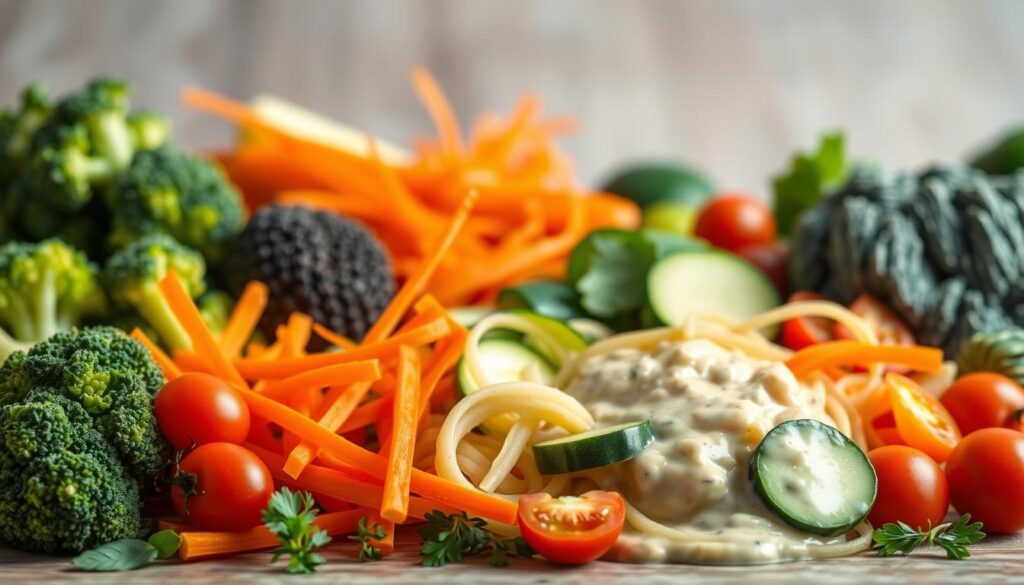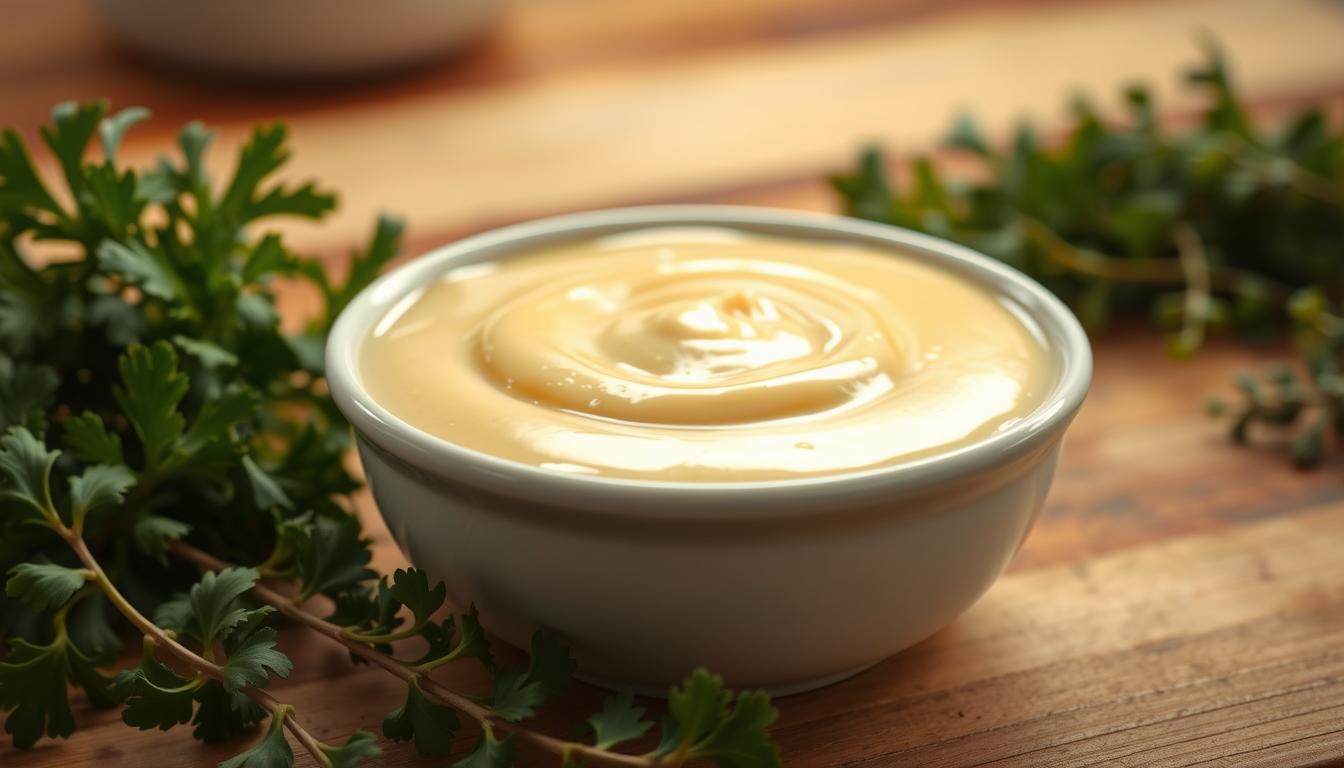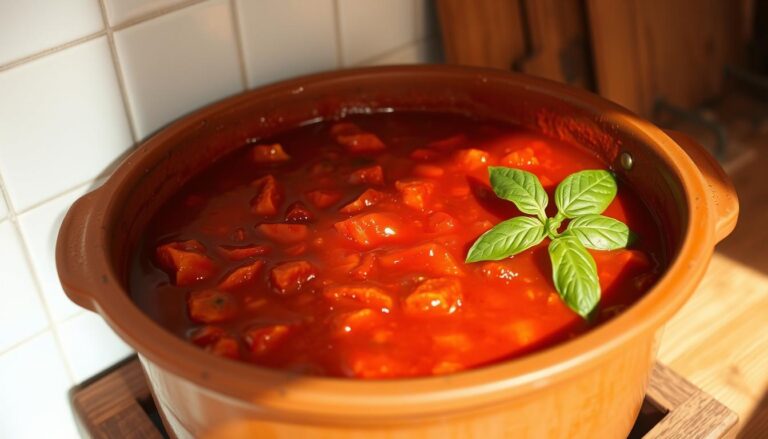How do you make Alfredo sauce taste better?
Ever made an alfredo sauce that just fell flat? You’re not alone. Many home cooks struggle with bland, grainy, or thin results. Whether you’re using a jar or making it from scratch, a few tweaks can make a big difference.
The best alfredo sauce recipe isn’t just about cream and cheese. It’s about layering flavors, choosing quality ingredients, and mastering key techniques. A great alfredo sauce coats pasta in silky richness and offers deep, complex flavors.
From simple fixes like adding fresh garlic to more creative solutions like unexpected cheeses, this guide will show you how to improve your alfredo sauce. Even a store-bought jar can become special with the right enhancements.
Key Takeaways
- Use high-quality Parmigiano-Reggiano and unsalted butter for the best flavor foundation
- Roasted garlic creates deeper flavor than raw garlic in alfredo sauce
- Fresh herbs like basil, thyme or sage can elevate a basic alfredo sauce
- Room temperature cream and cheese help prevent grainy texture issues
- Proteins like grilled chicken, shrimp or pancetta add dimension to alfredo sauce
- Even store-bought alfredo sauce can be significantly improved with fresh ingredients
Understanding Classic Alfredo Sauce Basics
Mastering classic Alfredo sauce is key to elevating your pasta dishes. This creamy sauce has won hearts around the world. Yet, its humble beginnings and what makes it authentic are often overlooked.
The History of Traditional Alfredo Sauce
In 1914, Alfredo di Lelio created a simple sauce for his pregnant wife. It was just butter and Parmesan, with no cream. American tourists later brought this sauce to the United States.
In the U.S., the recipe evolved into a creamier version. While some prefer the original, both have their own charm when made from scratch.
Essential Ingredients in Authentic Alfredo Sauce
The right ingredients are crucial for a great Alfredo sauce. The traditional Italian version needs:
- High-quality unsalted butter
- Freshly grated Parmigiano-Reggiano cheese
- Pasta water for silky texture
The American version adds heavy cream for a richer taste. Garlic and black pepper are also common, adding to the sauce’s flavor.
Common Mistakes When Making Alfredo Sauce from Scratch
When making Alfredo sauce, avoid a few common mistakes. Using pre-grated cheese with anti-caking agents can make it grainy. Overheating or rushing can also ruin the sauce.
Using low-quality ingredients can affect the flavor. Cold ingredients can cause the sauce to break. But with patience and care, you can make a sauce that rivals restaurant quality.
Quality Ingredients: The Foundation of an Exceptional Alfredo Sauce
The secret to the best alfredo sauce recipe is in the ingredients, not in complicated techniques. Choosing top-notch ingredients makes your homemade alfredo sauce stand out without extra work.
European-style butter has more butterfat than regular butter, making your sauce richer. Freshly grated Parmigiano-Reggiano adds complex flavors that pre-packaged cheese can’t. Organic heavy cream gives a cleaner taste and smoother texture, turning simple alfredo into something special.
Smart shopping is key when picking alfredo sauce ingredients. Look for:
- Cultured butter with at least 82% butterfat
- Cheese with “Parmigiano-Reggiano” stamped on the rind
- Heavy cream without additives or stabilizers
- Fresh garlic instead of pre-minced options
You don’t have to spend a lot. The cheese has the biggest flavor impact, and premium butter changes the texture. Regular salt is okay if you’re on a budget.
| Basic Ingredient | Premium Upgrade | Flavor Impact |
|---|---|---|
| Regular butter | European-style butter | Medium |
| Pre-grated cheese | Fresh Parmigiano-Reggiano | High |
| Standard heavy cream | Organic heavy cream | Medium |
For dietary needs, plant-based butter and cashew cream can make tasty dairy-free versions. The quality of these alternatives is crucial for making great homemade alfredo sauce.
Adding Depth of Flavor to Your Homemade Alfredo Sauce
A basic homemade alfredo sauce can become a masterpiece with the right touches. To go from good to great, know how ingredients blend for depth and complexity.
Incorporating Different Cheese Varieties
The cheese you choose is key to your sauce’s flavor. While Parmesan is classic, mixing it with other cheeses can be amazing. Try adding:
- Pecorino Romano for sharp, salty notes
- Asiago for nutty undertones
- Fontina for a buttery meltability
- Gruyère for subtle sweetness
Adding Roasted Garlic for Complexity
Roasted garlic makes your sauce special. Cut the top off a garlic bulb, drizzle with olive oil, wrap in foil, and bake at 400°F for 30-40 minutes. This turns garlic into sweet, mellow cloves that enrich your sauce.
Using Fresh Herbs to Elevate Your Sauce
Fresh herbs add a bright touch to your sauce. Top it with chopped parsley for color and freshness. Chives bring a hint of onion, while basil adds sweetness. For a twist, add a pinch of thyme or tarragon.
The Power of Quality Seasonings
Don’t just use salt and pepper. A little nutmeg can enhance dairy flavors without sweetness. White pepper adds heat without specks. For a special touch, add truffle oil or truffle salt.
Creating the Creamiest Alfredo Sauce Possible
The secret to a top-notch creamy alfredo sauce is in the ingredients and how you make it. You can make a smooth, restaurant-quality sauce at home. Just follow a few key steps to turn simple ingredients into a rich pasta sauce.
Choosing the Right Dairy Products
Starting with the right dairy is key for alfredo sauce from scratch. Heavy cream gives the richest flavor because of its high fat. Half-and-half makes a lighter version. Adding 2-3 tablespoons of cream cheese or mascarpone makes it even creamier without losing flavor.
Proper Techniques for Silky Smooth Texture
To get that silky texture in easy alfredo sauce, you need patience and the right steps:
- Heat ingredients gently over medium-low heat
- Add cold butter in small pieces, whisking constantly
- Warm cream separately before combining with cheese
- Grate cheese finely and add gradually off heat
Thickening Methods for the Perfect Consistency
Getting the right thickness for your creamy alfredo sauce might take some tweaking. Traditional recipes use reduction and emulsification. But, there are quicker ways for home cooks who want reliable results.
| Method | Best For | Technique |
|---|---|---|
| Reduction | Traditional approach | Simmer gently until thickened |
| Pasta Water | Natural thickening | Add 2-3 tbsp starchy cooking water |
| Cornstarch Slurry | Quick fix | Mix 1 tsp cornstarch with 1 tbsp cold water |
Protein Mix-ins to Transform Your Basic Alfredo Sauce
Make your homemade alfredo sauce a standout by adding protein mix-ins. The creamy sauce is a great base for savory proteins. They add flavor and make the dish more filling.
Seafood like crab meat, shrimp, or lobster can elevate your alfredo. Add lump crab meat just before serving for a fancy touch. Sauté shrimp in butter and garlic for a delicious twist. Lobster chunks poached in white wine make it a special treat.
Poultry like chicken or turkey goes well with alfredo sauce. Mix in diced grilled chicken breast while the sauce simmers. It absorbs the creamy flavors. Smoked turkey adds a unique taste that pairs well with the sauce.
- Bacon – crisp, crumbled, and folded in just before serving
- Pancetta – diced and lightly crisped to release savory oils
- Prosciutto – thinly sliced and added at the last minute
When using cured meats, don’t add too much salt to your sauce. A bit of lemon juice can brighten seafood additions. Aim for a 1:3 ratio of protein to sauce for the best taste.
Timing is key when adding proteins. Seafood should be added last to avoid overcooking. Hearty meats can handle longer cooking times. With these tips, your alfredo sauce becomes a complete meal that wows everyone.
Vegetable Additions for a Nutritious Alfredo Sauce Upgrade
Make your alfredo sauce healthier without losing its creamy taste. Adding veggies boosts vitamins and can make it taste and feel better.
Roasted Vegetables That Complement Alfredo Flavors
Roasting veggies makes them taste deeper and adds to your alfredo sauce. Use caramelized onions (½ cup) for sweetness, roasted red peppers (¼ cup) for color, or mushrooms (¾ cup) for a meaty flavor. Toss them with 1 tablespoon olive oil and roast at 425°F until they brown – about 20 minutes.

Pureeing Vegetables for Hidden Nutrition
Blend steamed cauliflower (1 cup) until smooth for a creamy sauce without extra calories. Butternut squash (¾ cup) adds sweetness and color. Make sure to drain the veggies well before blending and adding to your sauce.
- Steam vegetables until fork-tender
- Pat dry with paper towels
- Blend with ¼ cup of your alfredo sauce
- Fold puree into remaining sauce gradually
Fresh Vegetable Garnishes for Texture and Color
Fresh veggies add a pop of color and freshness to your alfredo sauce. Add halved cherry tomatoes (⅓ cup), baby spinach (½ cup), or fresh peas (¼ cup) in the last minute. These add vibrant colors and crisp textures to your creamy sauce.
| Flavor Impact | Vegetables | Best Addition Method |
|---|---|---|
| Mild | Cauliflower, Zucchini, Peas | Pureed or fresh |
| Medium | Bell Peppers, Spinach, Broccoli | Roasted or fresh |
| Bold | Mushrooms, Caramelized Onions, Sun-dried Tomatoes | Roasted |
Unique Flavor Boosters for an Unforgettable Garlic Alfredo Sauce
To make your garlic alfredo sauce truly special, think outside the box. The best recipes add unique touches that make the sauce rich and complex.
Unexpected Ingredients That Work Surprisingly Well
Try these surprising ingredients to elevate your alfredo sauce:
- A teaspoon of white miso paste adds a deep umami flavor
- ½ teaspoon lemon zest adds a bright, zesty note
- A dash of nutmeg brings out the cream’s sweetness
- ¼ teaspoon anchovy paste adds savory depth without fishiness
International Flavor Inspiration for Your Alfredo
Explore global flavors in your alfredo sauce with these ideas:
- Middle Eastern: Mix in 1 tablespoon tahini and sprinkle with za’atar
- Spanish: Add ½ teaspoon smoked paprika and minced roasted red peppers
- Thai: Blend in 1 teaspoon green curry paste and lime zest
Creating Signature Alfredo Sauce Variations
Make your own unique garlic alfredo sauce. Start with quality cream and parmesan. Then, mix and match flavors like roasted garlic + thyme + lemon zest or caramelized shallots + sage + black pepper.
| Base Alfredo | Aromatic | Herb | Accent |
|---|---|---|---|
| Classic | Roasted garlic | Thyme | Lemon zest |
| Extra creamy | Shallots | Basil | Sun-dried tomato |
| Parmesan-rich | Black garlic | Rosemary | Truffle oil |
Troubleshooting Common Alfredo Sauce Problems
Even the most skilled cooks can run into issues with homemade alfredo sauce. Luckily, most problems have easy fixes. Sauce separation occurs when heat is too high or applied too fast. To solve this, take your sauce off the heat and whisk in cold cream slowly until it’s smooth again.

Grainy texture often comes from adding cheese too quickly or at too high a temperature. When making alfredo sauce from scratch, always take the pan off the heat before adding cheese. Then, add it a little at a time, stirring constantly until it’s fully melted.
- Too thick: Thin with warm pasta water, adding one tablespoon at a time
- Too thin: Simmer gently until reduced or add extra grated parmesan
- Bland flavor: Enhance with extra salt, freshly ground pepper, or a pinch of nutmeg
- Discoloration: Add a squeeze of lemon juice to brighten
When reheating classic alfredo sauce, do it gently over low heat with a splash of cream. This prevents separation. To keep the sauce silky, store it with plastic wrap pressed directly on the surface.
Making the perfect alfredo takes practice, but these tips will help you get it right every time. Remember, patience is crucial during cooking. Rushing can lead to common alfredo mistakes.
Conclusion: Perfecting Your Alfredo Sauce Journey
Making the perfect alfredo sauce is a fun journey. You start with the basics and then try new flavors. Each step lets you make your best alfredo sauce recipe your own.
Whether you want the creamiest sauce, more nutrients, or an easy alfredo sauce for guests, this guide helps. It shows you how to make your Alfredo sauce journey a success.
Cooking is all about trying new things. Start with a few tips and then add more as you get better. Soon, you’ll make Alfredo sauce that everyone will love.
So, turn on your stove and start making your Alfredo sauce. The possibilities are endless, and it’s going to be delicious.


